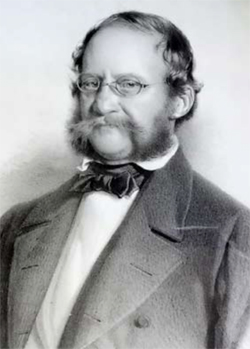
Council of Heads of Australasian Herbaria
Australian National Herbarium
Biographical Notes
 |
Council of Heads of Australasian Herbaria |
 Frauenfeld, Georg Ritter, von (1807 - 1873)
Frauenfeld, Georg Ritter, von (1807 - 1873)Frauenfeld
was one of seven scientists
on board the Austrian
frigate the Novara which
circumnavigated the
world in 1857-1859.
He had responsibility
for zoology and, along
with Ferdinand von
Hochstetter, the general
collection of natural
history specimens.
Based on original diary notes, the account of his
explorations to the north and south of the Sydney
environs during the Novara's visit there on 5 Nov
- 7 Dec 1858, was delivered to the Mathematical-Scientific Section of the Imperial Academy
of Sciences on 13 Oct 1859 and published the
following year.
The Novara scientists
amassed 26,000
botanical/zoological
specimens which in
addition to ethnological
material enriched
Austrian Museums.
The scientific results of the
journey were published in a 21-volume work
of the Vienna Academy of Sciences, Reise de
Oesterreichischer Fregatte Novara um die Erde,
in den Jahren 1857, 1858, 1859, published
between 1861 and 1876.
There is not a lot of evidence on the web of the
botanical collections which originated from
this expedition. Eduard Schwarz, ship's doctor,
and Anton Jelinek, horticulturist, were both responsible for the botanical activities of the
voyage. Schwarz was apparently out of his
depth in this area according to a contemporary,
Wawra, but two of his collections visible in Vienna through JACQ are
the lectotype of the Australian taxon Haloragis
tetragynus (Labill.) Hook. f. var. decumbens
Schindl. collected from Ash Island and the holotype of the New Zealand
species, Solanum apopsilomenum Bitter; a second
label other than the formal expedition label on
the latter specimen indicates that it was collected
from Mount [illegible] on September 28th 18[5]8
but this is unlikely to be correct.
For Anton Jelinek there are 69 specimens on
JSTOR, but only one of these is Australian and is
appropriately named Parmelia jelinekii Kremph.,
while there are three from New Zealand.
Others to collect plants on the voyage were
Frauenfeld and Hochstetter. Hypnum frauenfeldii Hampe, collected from Dapto, NSW, was named
for the former while Bazzania hochstetteri
(Reichardt) E.A.Hodgs., Cyperus hochstetteri
Nees ex J.Krauss and a naturalised species in
WA, Indigofera hochstetteri Baker, are named for
Hochstetter.
Some of the botanical collections (algae, lichens,
fungi, mosses and hepatics and Ophioglossaceae
and Equisetaceae) were written up in 1870
in the Botanischer Theil, part 3 of Reise der
österreichischen Fregatte Novara um die Erde
in den Jahren 1857, 1858, 1859...
SEE FULL ARTICLES:
by Heather Cunningham, and Robyn Barker, with references,
Australasian Systematic Botany Society Newsletter 178 (March 2019) p.30-33
( https://asbs.org.au/newsletter/pdf/19-march-178.pdf )
Source: Extracted from:
Cunningham H. (2019) Echidna overboard: Georg Ritter von Frauenfeld,
scientist on the 1857-59 world expedition of the Novara,Australasian Systematic Botany Society Newsletter 178 (March 2019)
Barker, R. (2019) Botanical collections from the Novara expedition, Australasian Systematic Botany Society Newsletter 178 (March 2019)
[see both articles for extensive references]
Portrait Photo: Extracted from first reference above, from Botanic Gardens of Adelaide collection.